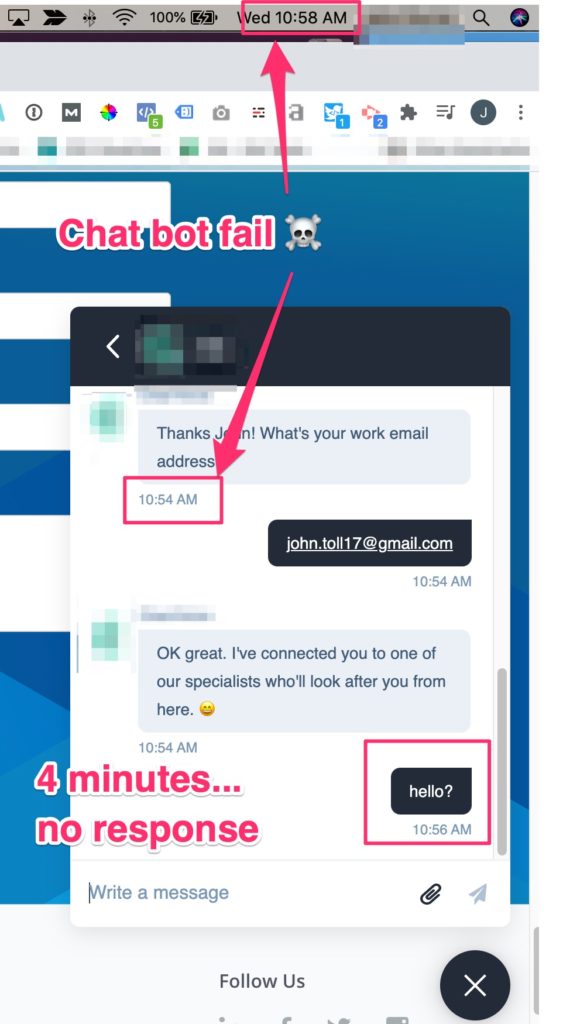Chatbots might be cool and flashy, but they can cost you leads when things go wrong.
The other day I had a pretty bad experience with a chatbot that cost a potential vendor my business.
If you’re thinking about using a chatbot for lead capture on your website, or if you’re already using one, then you need to read this.
Chatbots are all the rage today.
And I just don’t understand why.
When you think about it, the vast majority of chatbots out there are just glorified flowcharts composed of IF/THEN statements.
Yes, there are some really advanced chatbots out there that use AI, but even the best chatbots fall apart when it comes to understanding natural language patterns.
So, when I hear people say, “forms are dead. Long live chatbots!” I can’t help but laugh, because at the end of the day a chatbot is just a different type of form.
Don’t get me wrong, chatbots have their place and can work on the support side of a business where you have a support rep ready to jump in.
But using chatbots for lead capture?
It’s risky.
And overhyped.
Here’s a very short list of reasons why chatbots are overhyped.
- Human language and conversation are incredibly nuanced. Throw in a few slang words, passive voice, or regional dialects, then the chatbot breaks.
- It’s really hard to measure the effectiveness of chatbots across the funnel. Many marketers out there are deploying chatbots with no idea if the chatbot is actually adding any value. And let’s not even talk about how chatbots cause all sorts of attribution issues, making it hard to track your marketing campaigns properly.
- Consumers don’t have a ton of patience when it comes to chatbots. According to Venturebeat, “if the chatbot experience ends up being negative in the customer’s eyes, nearly 73 percent won’t use that chatbot again.” That’s not to mention the terrible impression that a bad chatbot experience leaves on your prospect.
- Most chatbots are designed to hand-off the “chat” to an actual person. The idea being that the “bot” pre-qualifies the lead, then passes it to a rep. This is great if you have a big sales team or someone sitting at a computer ready to respond. But, if you’re a small business and you don’t have time to sit on a computer live chatting with prospects, then you’re going to get yourself into some trouble, real fast.
- Finally, this is something that many people don’t think about. Chatbots naturally force sales and marketing teams to rush into a response in a reactive state. Yes, lead response times matter, BUT a strong case can be made for waiting to respond to the new opportunity when you’re cool, calm, and collected. The issue with the chatbot is that it sets the expectation that someone will follow-up right away, which might actually be putting your sales team in a bad position.
Finally, here’s a little story to drive my point home.
The other day I went looking for a new tool to help with some content marketing.
I came across a pretty cool tool to help me scale my content production up. I won’t name any names. But let’s just say that this company is in a very competitive space.
After browsing their site a bit, I somehow ended up on their chatbot.
I thought to myself, “Okay, let’s see what they have to say.”
I engaged with the chatbot, then went through a sequence of standard pre-qualification questions that most chatbots seem to ask. I.e, what’s your name, what’s your email address, etc)…
Finally, the chatbot told me to hang on a moment, while it handed me off to a friendly sales associate.
Moments passed…
No friendly sales associate =.
Then minutes passed… still nobody.
Keep in mind, even a few seconds is a very long time in the digital world.
I wrote, “Hello, is anyone there?”
No response.
Eventually enough time passed and I closed the chat and left their site all together.

Most people probably won’t even wait as long as I waited. I was just curious to see if someone would show.
Now, this is where you might be thinking…
“But wait! They had your email address. They can still follow-up with you.”
You’re right. That’s exactly what happened.
A few hours later, I received a follow-up from a friendly sales rep who apologized for the issue with their chatbot.
The email was nice and thoughtful, but by that point, I already had lost interest and moved on with my life.
I guess you can say that the experience with the website and chatbot put such a bad taste in my mouth that I lost trust in the company to be able to handle my business.
The bottom line:
If you’re responsible for marketing at a company that doesn’t have a huge sales team or the resources to man a chatbot (like most local service businesses and startups out there), then I suggest you ditch the idea of a chatbot altogether. At least for lead capture. Especially if you’re doing anything that requires paid media. You’re better off with a form, even though it’s not as trendy.
Now, if you want something friendly like a chatbot, that works around the clock without requiring you to provide an instant response to your prospects, then a better chatbot alternative is an interactive, conversational form — like what we built at LeadForms.
When I built LeadForms, one of my goals was to build a tool that is like a cross between a form and a chatbot.
This is when LeadForms came to life.
You can see an example of a conversational LeadForm in-action here.

